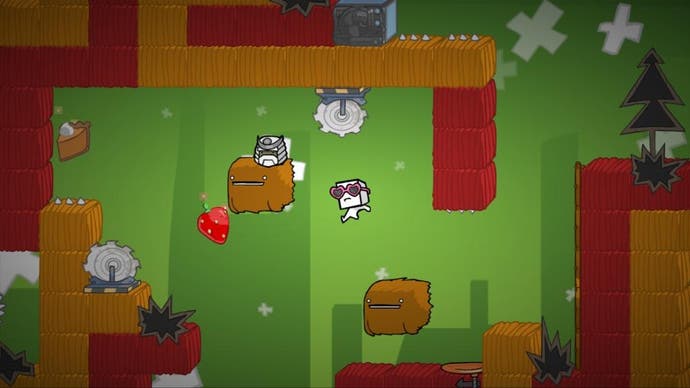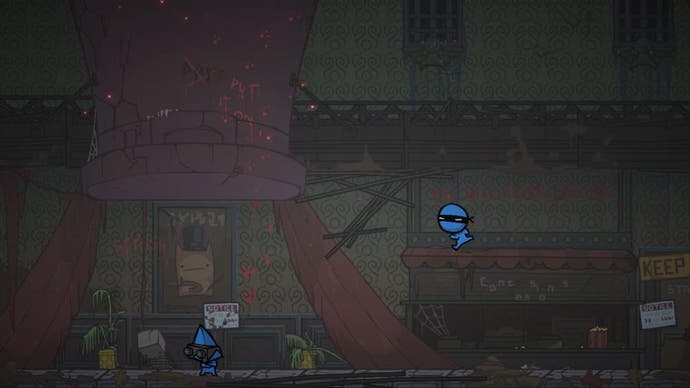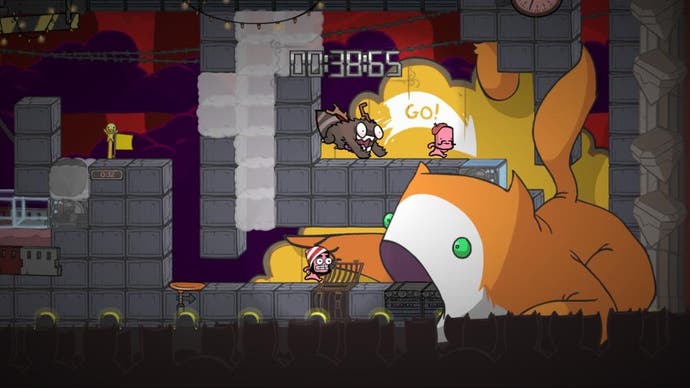Battleblock Theater review
All the world's a stage.
The Behemoth is growing up. You're over halfway through Battleblock Theater, the indie developer's latest, before you get to see someone poo themselves to death. Considering the team's previous game, 2008's Castle Crashers, had a variety of woodland creatures suffering from varying degrees of terminal diarrhoea within the first few levels, this clearly represents a significant stride towards maturity.
Thankfully, such restraint doesn't mean that Battleblock Theater has abandoned the studio's goofy, surreal sense of humour. Quite the opposite. This is by far The Behemoth's funniest game, with a laugh-out-loud narrator spinning a barking mad tale about weird little puppet people with interchangeable heads, shipwrecked on an island ruled by sadistic cats who force the refugees to survive deadly gauntlets in a shabby theatre for their feline amusement.
The core of this torment takes the form of a platform game, and a spectacularly good one at that. Each section of the game contains nine tightly paced platforming stages, one against-the-clock grand finale and three optional "encore" stages designed to test your skills to the limit. All are exquisitely designed, and go a long way to explain just why it's taken The Behemoth the better part of five years to follow up its previous hit.

In its previous work, the developer showed a knack for silly mayhem but displayed little in the way of nuance. From Alien Hominid's ruthless difficulty to the button-mashing insanity of Castle Crashers, it was more about slapstick energy than deep gameplay systems. Battleblock Theater, for all its silliness, is a more precision-tooled affair.
You need to collect at least three green gems to open the exit to any one stage, but there can be as many as seven to find. Also hidden somewhere in each level is a ball of yarn, and occasionally a golden top hat that must be hauled to the exit. Death drops the hat, but a bounty of ten additional gems is granted to the player who carries it over the finish line. These all feed into the game's economy, where gems unlock more characters from the island's gift shop prison, while yarn can be traded with the cat guards for new weapons: boomerangs, golf balls, vacuum cleaners and so on.
All the elements come together beautifully in the solo stages, with gems guarded by configurations of traditional platforming hazards such as spikes and deadly pools of water, testing your puzzling abilities as much as your dexterity. Often, the challenge is not just how to find the collectibles but how to reach them, and the game's deepest joys come from the way these situations test you on multiple levels at the same time and intertwine in stages that are an absolute joy to explore. You don't need to get an A++ grade to proceed, but such is the gravitational pull of the game's design that you'll want to anyway.

It's no exaggeration to say that this is platform game design that can stand alongside Super Mario Bros. and Rayman Origins as an example of how the genre should be done. The game never stops introducing new ideas, and always does so in a way that means progress is a learning curve, building on what came before and pushing you to do better. Every jump matters, every gem becomes a miniature game in itself, every screen begs to be picked clean of every last secret. Even skilled players will find themselves returning to stages over and over, trying to get the maximum rank by not only finding everything but doing so in the fastest way possible.
This is platform game design that can stand alongside Super Mario Bros. and Rayman Origins as an example of how the genre should be done
It's just a pity that the game becomes significantly less interesting whenever it deviates from this sublime core. Combat with the evil cats populating the levels is a sludgy affair, an especially strange weakness given how well melee combat was implemented in Castle Crashers. Later in the game, there are moments where the chaos of The Behemoth's other games begins to seep in, with sections that spam the player with explosions or monsters, gumming up the clockwork pacing that shines elsewhere.
Playing the story levels in co-op is also sadly less fun than playing solo. Characters have a habit of tangling each other up, and while certain areas are changed so that you can boost, pull or throw your partner, the benefit to gameplay isn't enough to compensate for the less refined focus. The camera lurches in and out to keep you both on screen, and coordinating movements can become a pain rather than a pleasure. Played in a pair, the game simply loses enough of the grace and flow that makes the single-player shine to make co-operative the second best option when it should be the crowning glory.

This clumsiness extends elsewhere. There are eight multiplayer modes, ranging from a simple "muckle" where two teams of two players bounce around a small arena screen and try to batter each other, to more conceptual trials where players must grab gold, paint walls or try to put a ball in a net. As with the co-op stages, confusion tends to reign, especially as the rules for some of the modes are a little woolly. Much like the "All You Can Quaff" eating contests from Castle Crashers, these offerings are an amusing side dish but are unlikely to endure unless you fancy chasing the Achievement for 100 victories in their slapstick challenges.
Just when you think Battleblock is spreading itself too thin, it pulls everything back together with a simple yet effective level editor. Far easier to grasp than LittleBigPlanet's ingenious but daunting system, this is an intuitive pick-and-place editor that is flexible enough to recreate anything you've seen in the main game. Levels can be saved in playlists that mimic the structure of the story campaign and shared instantly with the community. It's this, rather than the scattershot mini-games, that will give the game legs enough to outlast its Xbox Live Arcade rivals.
In keeping with The Behemoth's anarchic sensibilities, Battleblock Theater is a glorious tangle of ideas but it quickly reveals itself to be something very special. There are moments of glorious frustration, as there are in any great platformer, but the sting of such hurdles is always soothed by the sweetness of victory when you overcome them. If the structure were as graceful as the gameplay, this would be a near perfect game. Cut through the lunatic clutter surrounding its beating heart and you'll still find a masterclass in pure game design.









